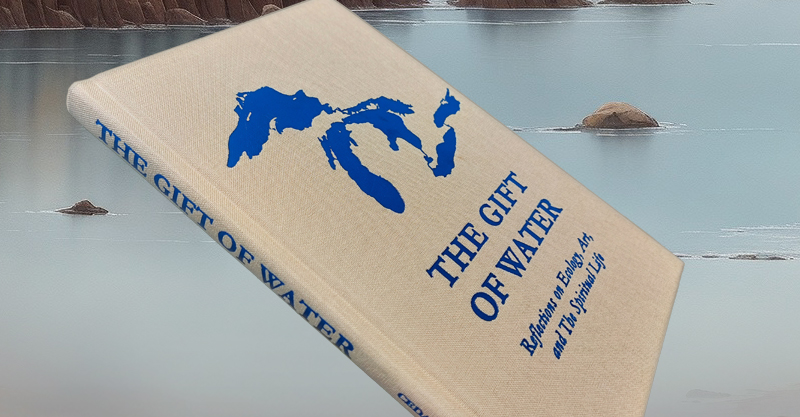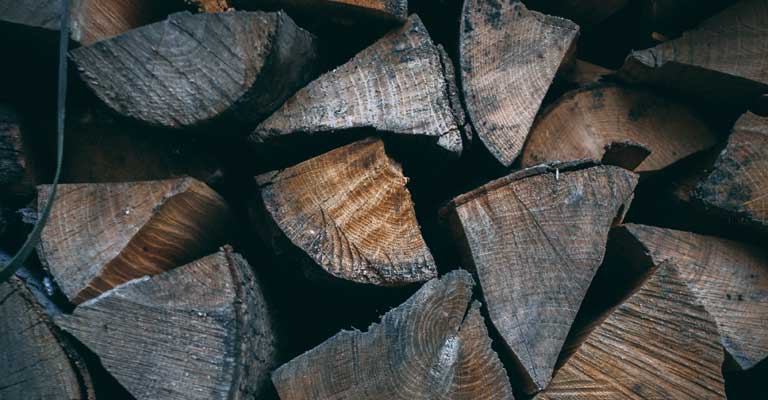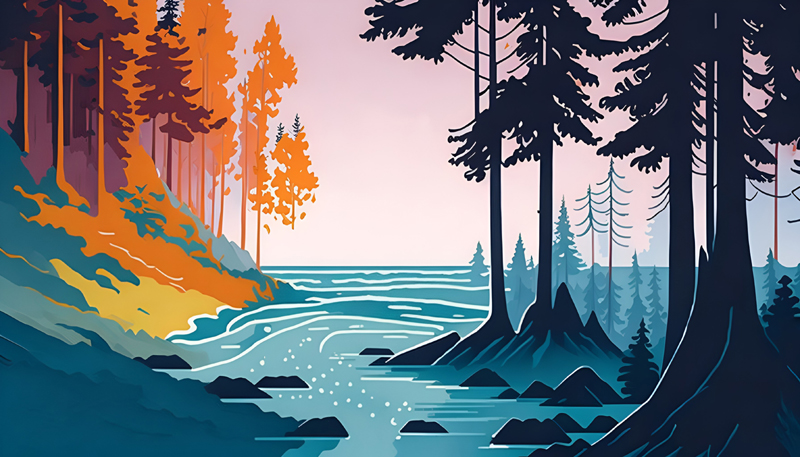from Marquette Monthly December, 1999
Before me on our dining room table, I open a cardboard storage box, removing a set of small newspaper-wrapped figurines. Each piece is part of a manger scene, a crèche passed down as part of a family’s Christmas tradition. In the earliest days of my youth, it was, of course, the animals in that collection that always caught my attention. As a young boy, I fondly remember one delicate, graceful creature set apart amidst this strangely mismatched arrangement: A tiny plastic reindeer.
Tonight, on the north edge of our city, where rock and forest meet the cold, windswept waters of Lake Superior, there roams in the shadows, among the leafless trees of Presque lsle Park, a band of whitetail deer. Over the last years, but especially in recent months, these shy and graceful creatures have become the focus of front-page newspaper articles and neighborhood quarrels. They remain, unknowingly, at the center of an emotional and sometimes bitter community controversy.
At first glance, the problem appears simple and straightforward: Should citizens be permitted to feed deer in our city park? As of October, new state deer feeding regulations have made it a misdemeanor to feed whitetails on public land. That legislation was triggered by increasing problems of over browsing and the transmission of disease among animals who share common food sources at close proximity. There remains one exception to this law: A supplemental winter deer feeding permit between January and May. That possibility is now before our City Commissioners.
The more visible factors framing this issue are rooted in the uneasy acknowledgment of the brutal dynamics of life in the natural world. northern winters are long and cold. The severity of Michigan’s chilling winds, ice and snow have always threatened, and continue to impact the healthiest of herds. During long winters for thousands of years, the specter of death has haunted the whitetails of Northern Michigan and, up until recently, human communities as well. The earth freezes, temperatures drop, ever mounting drifts of snow cover eatable forage while preventing escape from predators. The Ojibwa, long ago, recognized the danger of these coming winter months and called them “Time of the Starving Moon.”
On one side of the controversy are biologists and city residents, many of the latter who live on the edge of the park. They warn us about human interference with a more natural life cycle of wildlife and the destruction of property due to artificial feeding practices and the subsequent over-browsing of vegetation. On the other side are countless visitors and “friends” of the island deer who have become faithful supporters of the winter feedings; many make the daily drive to the island as a deeply felt commitment. For some, this ritual is a personal response to a deep stirring of compassion, an echo of a Biblical sensibility that “As you do this to the least of them, you do it also to me.”
Lines are not neatly drawn between the two camps as one would imagine. Two avid hunters, long-time residents of Marquette, have shared with me their opinion that the deer should remain, the feeding continue. The argument of a “natural wild” place where human contact is minimum, they reminded me, doesn’t exist except in Walt Disney movies or National Geographic Specials. The human imprint is everywhere, they asserted, including the peculiar profile and predominance of deer populations. Logging practices, hunting regulations, and public policy continue to dramatically shape the way we look upon wildlife and determine our relationship to deer and other creatures of the forest. We should, they maintain, reduce the island’s deer population but work around the present relationship as best we can.
The battleground for this peculiar environmental face-off is Presque Isle Park, which translated means “almost an island.” The park is a 323-acre peninsula sculpted by rugged pre-Cambrian lava rock, picturesque forest and sandstone cliffs. Archeologists remind us that the presence of awls, projectile points, beads and copper tools found near the road entrance to the park in the early 1900s suggests that the island was once a major trading site for Native Americans. Charles Kawbawgam (1799-1902), an Ojibwa leader, lived in Marquette for more than fifty years in a small dwelling on the southwest side of Presque Isle and eventually moved into a cabin nearby. In the last years of the 19th century, Kawbawgam, well known for his dignity and geniality, carried mail from settlement to settlement in the Marquette region. His grave is located on the east side of the park with that of his wife, Charlotte, daughter of well-known Chippewa leader Marje Gesick.
The land on which the park is now situated was surveyed and reserved by the federal government for a lighthouse site in 1846. Peter White, an influential civic leader, contracted a U.S. topographical engineer in charge of this lighthouse district and collaboratively helped draft legislation that granted ownership of the property to the city. Presented to Congress in March of 1886, the bill was passed into law by President Cleveland in July of 1886. The bill included the provision that “if it (Presque Isle) shall cease to be used as a public park such lands shall revert to the United States.”
White, who at the time was serving as President of the Park Commission for the City, contracted a nationally known design firm recognized for its vision in planning urban parks (including Central Park in New York and the Golden Gate Park in San Francisco). In their concluding recommendations, the planners wrote, “We congratulate Marquette on having one of the most beautiful parks in the world, and do earnestly advise that its natural beauty be religiously preserved at whatever inconvenience, as it will be worth far more than any art and wealth can create in a park.”
For many Marquette residents and visitors to the city, Presque Isle has served, as an invitation into what the philosopher of religion Rudolph Otto once called the Mysterium Tremendum et Fascinas, or “experience of the holy.” A few winters ago, during a fierce winter blizzard, a good friend of mine, a parish pastor and woodsman, awoke his teenage son in the middle of the night and whispered invitingly, “Grab your snowshoes, we’re going out to the island.” In a dark wind and freezing force of a January blizzard, they traversed together the shores and cliffs of Presque Isle. It was a father’s introduction of his son to the fierce mysteries of the natural world. He chose as his cathedral that winter night something more powerful than anything ever built with stone and marble.
Over the decades, numerous geologists have scrambled along Presque Isle’s rock formations, dozens of lovers skied its moon-lit winter trails and thousands of children run winding trails. Priests and paupers have stood on its shores for a hundred years, looking out, searching for meaning on the horizon. For over a century, the unforgettable benchmarks of human drama have been etched within the park’s boundaries: weddings, baptisms, murders and drownings on and near its shores.
In 1897 a zoo was built on the island. The first deer in the park were a gift from William Whearley, keeper of the Marquette Lighthouse. At that time, the deer were allowed to run wild. In 1932 a building of concrete and iron was constructed and it is believed that the deer roaming Presque Isle were herded into the new zoo. In the spring of 1994, new USDA regulations prohibited contact between penned animals and humans. The deer pen was torn down an the herd released onto the island. Because of the land bridge, the exact number of the park’s deer population remains in a relative continuing flux.
The whitetail deer that roam Presque Isle tonight are, of course, part of a larger story. The history of these creatures in the Upper Great Lakes Region is fascinating and complex, an untidy, oftentimes blood-soaked collision of human and animal worlds. It’s helpful to remember that for centuries northern Michigan did not provide good natural habitat for deer. The earliest Jesuit and French explorers recorded a lack of good hunting among the Indians and filled their journals with numerous accounts of starvation and malnutrition among the indigenous peoples of Lake Superior’s south shore. A major problem was the huge forests of white pine. With their lack of understory, they were not conducive to deer populations. Beaver and fish were more abundant. Because of the Peninsula’s severe winters, deer regularly migrated to the south from December through April.
Throughout the Upper Great Lakes region, even today, only a relatively small portion (naturalists estimate about 10%) of the total deer range can support whitetails during most winters. Survival becomes a bitter test. With the extreme cold-stress and mounting snow depths, deer typically crowd into “yards,” most frequently in areas of northern white cedar where there’s protection from drifting snow and available nutrition. Hundreds of deer crowd into these yards and compete aggressively for shelter and limited food. In hard winters, many of these traditional deer yards become the “killing fields” for natural predators like coyotes and wolves.
Naturalist and photographer George Shiras III contended that during the early 19th century, before the logging of mature pines, whitetails living along the south shore of Lake Superior migrated seventy-five miles or more to more favored wintering grounds in what is now northern Wisconsin. According to Shiras, “The great depth of snow in this region was the original cause of the fall migration of deer… The deer traveled southward on many trails which by centuries of use had become several feet broad, clear of obstructions, and deeply cut in banks and soft ground. In many swamps they were like the caribou trails found in Newfoundland.”
Partly because of inconsistent logging practices and a lack of natural predators, but also because of the laws of nature, the threat of starvation is part of whitetail’s life. It’s not an attractive picture. Death by malnutrition is a slow and bitter process. Fat depletion and physical weakening progress initially with undetectable signs. Then suddenly a deer’s coat becomes rough, its hip bones begin to show, shallows appear in its flanks. A starving animal spends most of its time bedded down. Small deer, especially, stand hump backed, their front legs spread slightly. Although some small deer may succumb to malnutrition early in winter, most deer who will die do so during March and April.
John Ozoga, a biologist and long-time student of whitetail deer populations in the Upper Peninsula, after personally trudging on snowshoes winter after winter watching hundreds of deer starve in crowded cedar swamp yards, suggests our current hunting practices are an insult to the cycle of natural selection. He reminds us that wolves and coyotes, as well as the severity of winter, traditionally kill off the weak and old. The strongest deer are needed to propagate a healthy species. Yet these are the very creatures, he asserts, that we see as “trophy” bucks. These animals should not be prized as “good kill.” Instead, if we are to learn from nature’s wisdom, it would be the weak, the sick, and small we would seek as targets. Ozoga, of course, knows what most of us are afraid to say: To choose to kill the weak and sick is nature’s way. The truth is few hunters, much less the non-hunting public, has the stomach for it.
In July 1994, Bill Robinson, then a Biology Department faculty member at Northern Michigan University and well-respected naturalist, wrote a paper on the management of the deer herd on the island. Based on his study of the vegetation and habitat (what biologists call “carrying capacity”) the park, he reported, could appropriately support seven to twelve whitetails. In 1994 the fall census was 50. For the years following, the census has ranged from 78 to 35. In November 1998, Robinson, with a team of student and community volunteers, made another count using a standard design method and identified fifty whitetails. He recommended at that time the capture and translocation of deer to stabilize the herd. His position was an adamant one. He continues to hold to his conviction that there should be a “no-feeding of animals” policy at Presque Isle.
Robinson served as member of the Presque Isle Advisory Board and agrees with wildlife managers who discourage artificial feeding of deer and wildlife. Well-meaning people insist upon feeding deer, assuming every bit helps. But apples, potatoes, lettuce, corn, bread, and chocolate cake fail, experts agree, to meet the whitetail’s basic nutritional requirements. Table scraps are high-energy foods. They require the animal’s digestive system is in good physical condition. When regularly fed such foods, toxic quantities of lactic acid often accumulate and deer, as a result, become unable to process natural browsing feed in their digestive tracks. Later in spring, eager to return to a more natural diet, death awaits.
Outside tonight the wind is blowing. The temperature is dropping. Before me the crèche with its small animal figurines is a reminder that in some religious traditions, the divine is said to have been first born among the animals. C.S. Lewis, in his memorable series of children’s stories, The Chronicles of Narnia, has Aslan, the redemptive lion, appear after his death, dramatically but fleetingly, as a white stag on the edge of forest’s meadow. Lewis understood there is something in the eyes and presence of a single, solitary deer that speaks to the depths of the human heart. The 19th-century poet Rilke once wrote of this graceful and elusive spirituality:
Our community’s troublesome struggle over the feeding of a small group of deer masks a critical quest of learning to truly live with the land, to find our rightful place in it. In spite of impressive achievements of technology and science, environmentally we remain conflicted and confused. As a nation and community, we share no common vision. We have not yet learned how to blend human compassion with colder laws of the natural world.
Is this really a search to find some new balance between feeding starving deer and the inevitable ensuing destruction of precarious habitat, a pull of human compassion against a scenario of hundreds of deer dying from malnutrition? Or is the hardness of life in the animal world inviting us to pause, to mourn more deliberately the violence that is a part of every life? What lies behind our hesitation to face more gracefully the acceptance of a humble creature’s death in the freezing winter snow? On the deepest level, it may be a fear of human mortality, our own most deeply hidden terror.
On the edge of a new century, in the dark shadows of Presque Isle, a solitary doe emerges for a moment on the edge of the forest, and stares south into the distant twinkling lights of our city. Looking toward a strange world she will never fully comprehend, she slips quietly into the darkness. During the coming time of The Starving Moon, huddled tonight with her young beneath the cedars, she awaits our answer.
– Jon Magnuson
December 1999






